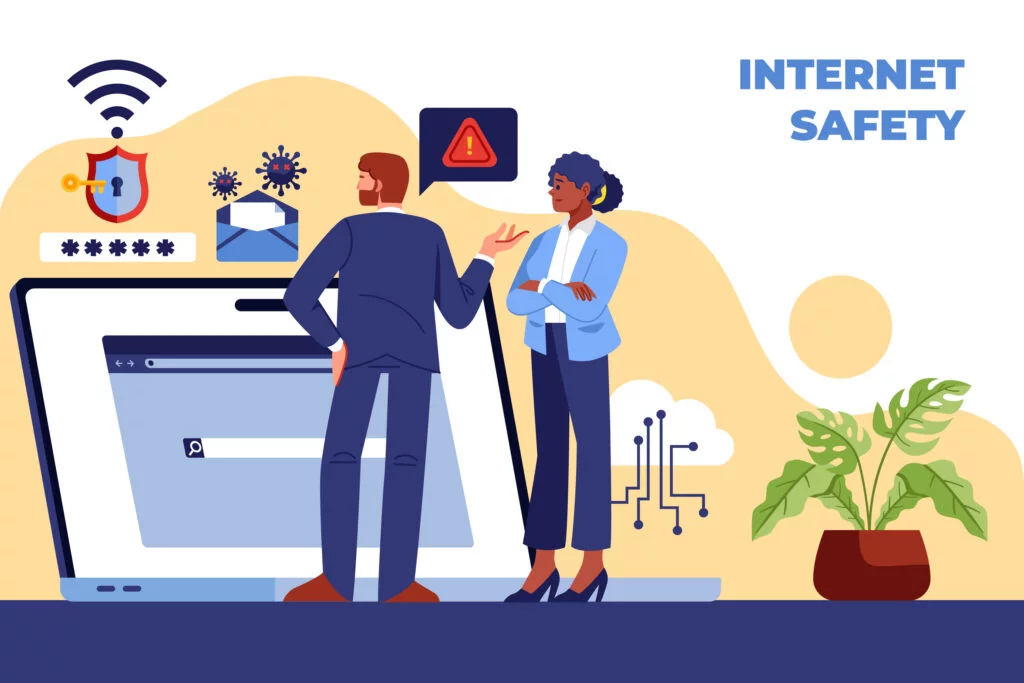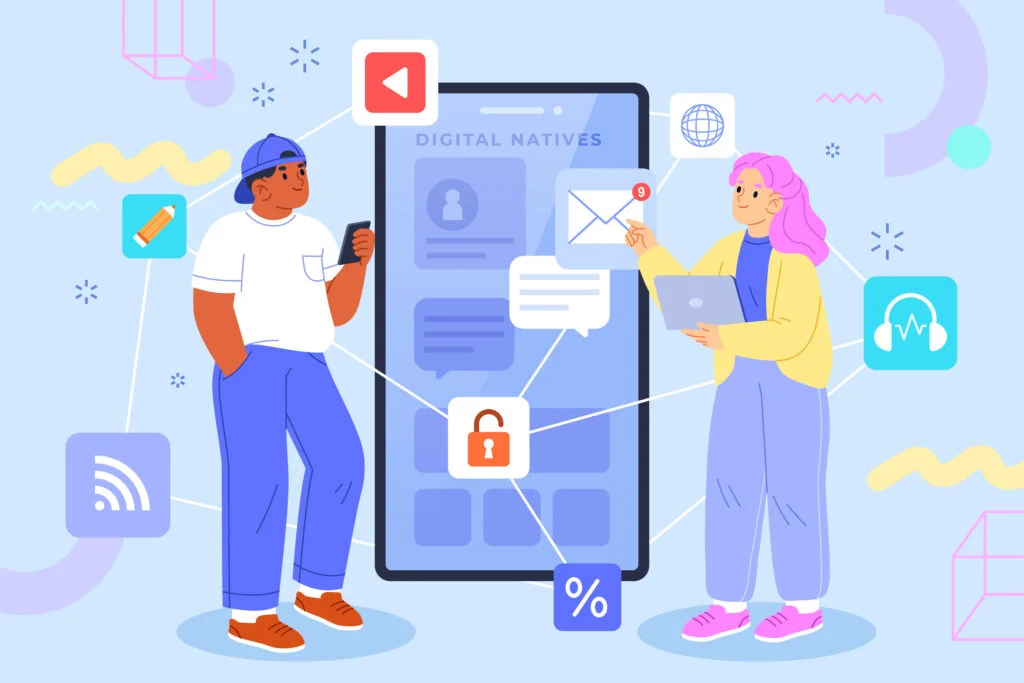Introduction
In our hyper-connected digital age, safeguarding your family’s online presence is as crucial as locking up your house at night. Just as you’d safeguard your home from burglars, securing your online presence is vital to protect your family against cyber threats. With countless tips and tools available, where should you start? Don’t worry! This guide will walk you through everything you need to know about digital security, safe browsing, cyber hygiene, and more. We’ll even throw in a few laughs along the way. So, buckle up and let’s get ready to dive into the digital security jungle!
1. Understanding Digital Security and Cybersecurity for Families

Digital Security involves safeguarding your family’s online activities from cyber threats. Think of it as setting up a high-tech security system, but for the internet. Cybersecurity for families ensures that everyone, from toddlers to teens, is protected online.
Key Components:
- Encryption: Encrypt your data like you’re wrapping it in a super-secure digital bubble. Even if someone intercepts it, they won’t get past the bubble wrap!
- Secure Passwords: Create complex passwords that are as hard to guess as your favorite celebrity’s pet’s name. Mix in letters, numbers, and symbols.
- Two-Factor Authentication (2FA): Think of 2FA as an extra lock on your digital door. Even if someone gets past the first lock (your password), they need the second key (your phone) to get in.
- Regular Updates: Keep your software updated as if it were the latest fashion trend. Outdated software is like wearing last year’s wardrobe—vulnerable to attacks!
Reference: Google Cloud’s 2023 Threat Horizons Report found that 86% of breaches involve stolen credentials, and credential issues account for over 60% of compromise factors—which could be addressed by stronger identity management guardrails in place at the organization level.
“Passwords are like underwear: don’t let people see it, change it very often, and you shouldn’t share it with strangers.” – Chris Pirillo
2. Implementing Effective Parental Controls
Parental controls are essential for managing your child’s internet use. They act like a digital babysitter, making sure your kids don’t stumble into the dark corners of the web.

Key Tools:
- Parental Control Software: Tools like Net Nanny or Qustodio are like having a virtual nanny who keeps an eye on what your kids are up to online.
- Family Safety Apps: These apps are like digital tracking devices, but less “spy thriller” and more “peace of mind.” They can help monitor locations and screen time.
- Content Filters: Block access to inappropriate sites like a digital bouncer at a nightclub.
- Time Limits: Set limits on screen time to avoid the dreaded “screen zombie” state your kids can fall into.
Statistics: According to Pew Research Center, 72% of parents use parental control software to keep their children safe online.
3. Ensuring Safe Browsing and Social Media Safety

Teaching your kids about safe browsing and social media safety is like giving them a map to navigate the wild internet jungle without getting lost or eaten by trolls.
Tips for Safe Browsing:
- Safe Browsing for Kids: Use child-friendly browsers like Kiddle or KidZui that filter out the digital junk food.
- Online Privacy Tips: Remind kids to avoid sharing personal information online—no need to post about the upcoming family vacation on a public forum!
- Recognize Phishing Scams: Teach them to spot phishing emails like a pro detective. If an email looks fishy, it probably is.
- Avoid Unknown Links: Clicking on unknown links is like opening a mystery box—you never know what might pop out.
“If you put a key under the mat for the cops, a burglar can find it, too. Criminals are using every technology tool at their disposal to hack into people’s accounts. If they know there’s a key hidden somewhere, they won’t stop until they find it.” – Tim Cook, Apple’s CEO
4. Protecting Family Data and Managing Digital Footprints

Data protection and managing your digital footprint are like keeping your home tidy and secure. A clean digital footprint means less risk of unwanted intrusions.
Strategies:
- Secure Home Wi-Fi: Use strong passwords for your Wi-Fi network. Think of it as your home’s digital “Do Not Disturb” sign.
- Digital Footprint Management: Regularly review your privacy settings and clear out old accounts like a digital decluttering session.
- Backup Data: Regularly back up important data. Losing it is like misplacing a key to your treasure chest.
- Monitor Privacy Settings: Adjust privacy settings on social media to avoid oversharing. Imagine your posts are visible to everyone in the world!
Reference: According to Kaspersky, One-in-five people admit that they share sensitive data with people they don’t know well, and with strangers, limiting their ability to control how their sensitive information will be used.
5. Combating Cyberbullying and Online Threats
Cyberbullying prevention and handling online threats are crucial for a positive online environment. Think of it as keeping your digital playground safe and fun for everyone.
Key Points:
- Cyberbullying Prevention: Educate kids about the signs of cyberbullying and encourage open communication. No one should feel like they’re stuck in a virtual bully’s playground.
- Online Threats Prevention: Stay informed about common threats like malware and phishing. Use antivirus software and educate your family on spotting suspicious activity.
- Report Suspicious Behavior: Teach kids to report any threatening or inappropriate online behavior. Be the online superhero who swoops in to save the day.
- Encourage Positive Online Behavior: Promote kindness and respect online. Remember, the internet is a community, not just a digital space.
Reference: According to Cyberbullying Research Center, approximately 55% of the teen in a 2023 survey reported that they experienced cyberbullying at some point in their lifetimes.
6. Educating About Internet Safety and Digital Footprints

Internet safety education is vital for empowering your family to navigate the web safely. It’s like giving them a digital survival guide.
Key Components:
- Understanding Digital Footprints: Explain how every online action leaves a trace. Avoid posting information you wouldn’t want to be seen by future employers or future selves.
- Cyber Bullying: It is a serious pandemic that is only growing with the increased use of social media. Talk to your kids and explain to them that they must approach your immediately if they feel that they are being cyber bullied.
- Teaching Digital Etiquette: Instruct your kids on proper online behavior. Imagine the internet as a global dinner party—everyone should use their best manners.
- Regular Safety Check-ins: Have periodic discussions about online safety. Treat it like a routine check-up, but for your digital health.
- Encourage Critical Thinking: Teach your kids to question the authenticity of online information. Not everything on the web is true, just like that spam email promising a million dollars.
Reference: According to GCFGlobal.org, if you’re a parent or guardian, you can help to keep your kids safe by talking to them about their Internet use, teaching them about online dangers, and learning everything you can about the Internet so you can make informed decisions.
7. Utilizing Family Cybersecurity Tools

Family cybersecurity tools are like the advanced security systems for your digital home. They provide added protection against various cyber threats.
Recommended Tools:
- VPN (Virtual Private Network): Use a VPN to encrypt your internet connection, making it harder for hackers to snoop on your online activities.
- Antivirus Software: Invest in reputable antivirus software to protect against malware and viruses. It’s like a digital immune system.
- Firewall Protection: Set up a firewall to block unauthorized access to your home network. Think of it as a digital moat around your castle.
- Secure Family Networks: Ensure all devices connected to your home network are secure and updated. Every device is a potential entry point for cyber intruders.
Reference: VPNs encrypt your internet traffic and your identity online, making it harder for third-parties to break in and steal your data. (Kaspersky).
8. Promoting Safe Social Media Use
Safe social media use involves teaching your family how to navigate social networks without exposing themselves to unnecessary risks.
Guidelines:
- Privacy Settings: Set social media accounts to private. It’s like drawing the curtains in your digital house—keep the view limited to trusted friends.
- Think Before Sharing: Encourage your family to think twice before posting personal information. No need to share your vacation plans or home address publicly.
- Beware of Scams: Educate about common social media scams. If it sounds too good to be true, it probably is!
- Report Suspicious Accounts: Teach kids to report fake accounts or suspicious messages. Don’t let those digital bad apples spoil the bunch.
“Privacy is dead, and social media hold the smoking gun.” – Pete Cashmore, Mashable CEO
9. Understanding Malware Protection

Malware protection is crucial for keeping your family’s devices safe from harmful software. It’s like installing an alarm system to catch any unwanted intruders.
Key Measures:
- Install Antivirus Software: Regularly scan for malware and viruses. It’s like a digital health check-up for your devices.
- Avoid Suspicious Downloads: Only download apps and files from trusted sources. If it’s not from a known source, think twice before clicking “download.”
- Keep Software Updated: Update your operating system and applications to patch any vulnerabilities. An updated system is a safer system.
- Educate About Malware: Teach your family to recognize signs of malware, like slower device performance or unexpected pop-ups.
Reference: 560,000 new pieces of malware are detected every day, according to Astra.
10. Maintaining Cyber Hygiene
Cyber hygiene involves practicing good habits to keep your family’s digital health in check. It’s like regular cleaning for your digital devices to ensure they stay secure and efficient.
Best Practices:
- Regular Software Updates: Ensure that all software, including operating systems and applications, is up-to-date. This helps patch vulnerabilities and protect against the latest threats.
- Clean Up Old Accounts: Delete old or unused accounts and apps. Each account is a potential entry point for cybercriminals, so fewer accounts mean fewer risks.
- Use Secure Connections: Always use secure connections (look for HTTPS in URLs) and avoid using public Wi-Fi for sensitive activities. Think of public Wi-Fi as an open house party—secure connections are your VIP lounge.
- Educate on Phishing: Teach family members to recognize phishing attempts and avoid clicking on suspicious links or attachments. Phishing scams are like digital fishing nets—don’t let them catch you off guard.
Quote: “Keep your digital life germ-free.”
Conclusion
Ensuring your family’s digital security might seem like a daunting task, but with the right tools and practices, it’s entirely manageable. By implementing effective cybersecurity measures, understanding the importance of online privacy, and using parental controls, you can create a safer online environment for your loved ones. Remember, digital security isn’t a one-time fix but a continuous journey. Keep up with the latest updates, educate your family, and enjoy the digital world safely—minus the cyber trolls and malware monsters!
Resources
- Google Cloud’s 2023 Threat Horizons Report
- Blue-Pencil.ca
- Pew Research Center
- Kaspersky
- Cyberbullying Research Center
- GCFGlobal.org
- Astra
- Wizcase – Kids Online: 40 Stats about Usage, Benefits, and Risks
Discover more from Total Security Digest
Subscribe to get the latest posts sent to your email.